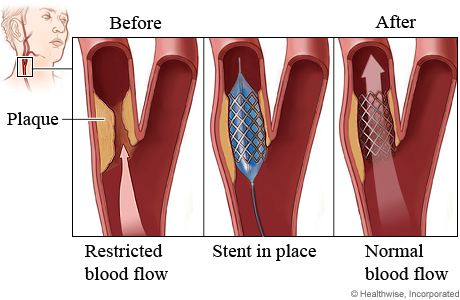Carotid artery stenting: Overview
Carotid artery stenting is a procedure to open a narrowed carotid artery. There is a carotid artery on each side of the neck. They supply blood to the brain.
Fatty buildup can narrow these arteries. This buildup is called plaque. When one or both of your carotid arteries are narrowed, it can make it hard for blood to flow to the brain. This buildup also raises your risk of stroke. This procedure may improve blood flow to your brain and lower your risk of having a stroke.
You will get medicine to prevent pain and help you relax. The doctor will put a small tube into a blood vessel in your groin or arm. This tube is called a catheter. The doctor will move it through the blood vessel to your carotid artery. Then the doctor will put dye into the catheter. The dye will make your carotid artery show up on X-ray pictures. This lets the doctor find the narrow section of the artery.
The catheter is used to move a balloon and an expandable tube, called a stent, into the artery. The balloon is placed inside the stent and inflated. This opens the stent and pushes it into place against the artery wall. The balloon is then deflated. The doctor will take out the balloon and catheter from your body. The stent will stay in your artery. After time, the cells lining the blood vessel will grow through and around the stent to help hold it in place.
The procedure usually takes about 1 to 2 hours. You may need to stay in the hospital for 1 or 2 days after the procedure.
Why is carotid artery stenting done?
Carotid artery stenting is done to help lower your risk of stroke.
Your doctor may recommend this procedure based on certain things. These include:
- The amount of narrowing (stenosis) in your carotid arteries. A procedure may be an option if the narrowing is 50% or more.
- Whether you had a stroke or TIA within the past 6 months. If you have not had a stroke or TIA, it is less clear that the procedure will help you.
Carotid artery stenting

During carotid artery stenting, a small, expandable tube called a stent is permanently inserted into the carotid artery.
To insert the stent, the doctor uses another tube called a catheter. The doctor inserts the catheter into a blood vessel in your groin or arm and moves it to the carotid artery.
A very thin guide wire is inside the catheter. The guide wire is used to move a balloon and the stent into the carotid artery. The balloon is placed inside the stent and inflated. This opens the stent and pushes it into place against the artery wall. The balloon is then deflated and removed, leaving the stent in place. After time, the cells lining the blood vessel will grow through and around the stent to help hold it in place.
After carotid artery stenting: When to call
Call 911 anytime you think you may need emergency care. For example, call if:
- You passed out (lost consciousness).
- You have symptoms of a heart attack. These may include:
- Chest pain or pressure, or a strange feeling in the chest.
- Sweating.
- Shortness of breath.
- Nausea or vomiting.
- Pain, pressure, or a strange feeling in the back, neck, jaw, or upper belly, or in one or both shoulders or arms.
- Lightheadedness or sudden weakness.
- A fast or irregular heartbeat.
- You have symptoms of a stroke. These may include:
- Sudden numbness, tingling, weakness, or loss of movement in your face, arm, or leg, especially on only one side of your body.
- Sudden vision changes.
- Sudden trouble speaking.
- Sudden confusion or trouble understanding simple statements.
- Sudden problems with walking or balance.
- A sudden, severe headache that is different from past headaches.
Call your doctor now or seek immediate medical care if:
- You are bleeding from the area where the catheter was put in your artery.
- You have a fast-growing, painful lump at the catheter site.
- You have signs of infection, such as:
- Increased pain, swelling, warmth, or redness of the skin.
- Red streaks leading from the area.
- Pus draining from the area.
- A fever.
- Your leg, arm, or hand is painful, looks blue, or feels cold, numb, or tingly.
Watch closely for changes in your health, and be sure to contact your doctor if you have any problems.
©2011-2026 Healthwise, Incorporated
